Clinical nutrition spans an understanding of basic nutritional principles to the application of nutrition in optimising health and the wellbeing of companion animals. In developed society, dogs and cats are most often fed commercial diets (Hill, 2009). In the UK, it is estimated that 13 million (46%) of households own a pet and the value of the UK pet food market is now £2.6 billion (Pet Food Manufacturers' Association (PFMA), 2014a) yet, traditionally, while 90% of pet owners would like a nutritional recommendation, only 15% perceive being given one (American Animal Hospital Association (AAHA), 2003). More recent findings suggest that around 30% of pet owners use ‘instinct’ when deciding how much to feed (PFMA, 2014b), demonstrating a need for accessible and accurate nutritional advice from the veterinary healthcare team. However, when communicating with clients about nutrition and making nutritional recommendations, it is also important to consider that 68% of pet owners do not follow professional guidelines when deciding portion size; an acknowledged contributory factor to the UK pet obesity epidemic (PFMA, 2014b).
Nutritional Assessment Guidelines developed by the American Animal Hospital Association (AAHA) and the World Small Animal Veterinary Association (WSAVA) have been designed to help the veterinary healthcare team and pet owners ensure that dogs and cats receive optimal nutrition, tailored to their needs (Baldwin et al, 2010; Freeman et al, 2011). These have since formed part of a wider nutritional assessment toolkit devised by the WSAVA Global Nutrition Committee and have been published worldwide and translated into several different languages. For veterinary staff, a key objective of these is to provide a framework and number of tools to assist in making a nutritional assessment, and specific nutritional recommendations, for every patient on every visit. Thus an understanding of basic nutritional principles and the application of nutrition in optimising the health and wellbeing of both fit and clinically affected companion animals is essential for all members of the veterinary healthcare team. The calculations and equations presented in this paper are intended for use in collaboration with these guidelines.
Energy requirements
Energy is measured in calories (cal), kilocalories (kcal) and kilojoules (kJ): 1 kcal = 1000 cal = 4.184 kJ. Heat is produced following the intake of a meal as a result of digestion and absorption. This process is known as meal-induced thermogenesis. Common terms used to describe the energy density of a food can be found in Table 1.
| GE | Gross energy |
| DE | Digestible energy |
| ME | Metabolisable energy |
| NE | Net energy |
When reviewing a particular pet food diet, the label is the primary means by which product information is communicated between a manufacturer or distributor and the consumer. Similar to food intended for human consumption, pet foods must be correctly labelled. Pet food labels in Europe are divided into two main sections although the distinction between the two is not as stringent as those in the United States. The information panel (statutory statement) identifies the typical analysis (the average percentage of the nutrient level calculated from several samples) of crude protein, crude fat, crude fibre and ash. Moisture must also be stated if it exceeds 14% (FEDIAF, 2011). The energy content of a diet is derived from fat, protein and carbohydrate (Table 2).
| Nutrient | Gross energy (GE) | Metabolisable energy (ME) |
|---|---|---|
| Fat | 9.4 kcal/g | 8.5 kcal/g |
| Protein | 5.7 kcal/g | 3.5 kcal/g |
| Carbohydrate (nitrogen free extract or NFE) | 4.1 kcal/g | 3.5 kcal/g |
From the information panel, the approximate metabolisable energy (ME) density of the diet can be predicted. The Atwater equation is used in human nutrition to predict the energy content of food. In contrast, the modified Atwater equation was developed by the Association of American Feed Control Officials (AAFCO) to predict the ME value of pet food and reflects lower digestibility of commercial pet food compared with human food. While other methods are available (National Research Council, 2006), the modified Atwater method outlined by FEDIAF (2013) provides an accurate yet quick and simple estimation of ME value using the typical analysis on the label of a pet food and can be calculated using the following steps:
Scenario one
Aslan, a 3-year-old domestic long haired cat, has been admitted to the veterinary hospital and the owner has provided some sachets of Aslan's usual diet, ‘Feline Favourite Cuisine’ for feeding during hospitalisation.
Using details of the analytical constituents listed on the pet food label (Figure 1) and the modified Atwater method outlined above, make a quick estimate of the ME density of the diet as fed.
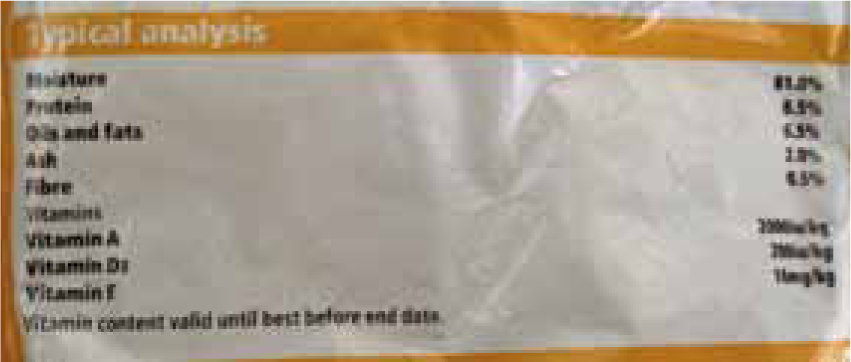
Scenario one — answer
ME density as fed
In this scenario, the percentage of NFE would be 1.5% (100 – 81 – 8.5 – 6.5 – 2 – 0.5) which, when multiplied by 3.5 kcal/g, equates to 5.25 kcal.
29.75 + 55.25 + 5.25 = 90.25 (x 10) = 902.5 kcal
The energy density of this particular diet would therefore be 902.5 kcal ME per kg or 902.5 kcal/kg ME. However it is important to consider that the guaranteed analysis only provides minimum values of protein and fat and maximum values of moisture, fibre and ash, not a precise quantity. This, combined with the variation in digestibility of pet foods, emphasises this value as an estimation of the ME content of the diet and recognises that no single equation will accurately predict the energy density of all diets (FEDIAF, 2013).
Calculating how much to feed
When a cat or dog presents with a history of anorexia or hyporexia, it is important to identify for how long the animal has been failing to consume its daily energy requirements. Depending on age, species and health status, animals should be left no more than a maximum of 3–5 days including the time before admittance. In patients with severe malnutrition, the immediate goals of therapy should focus on resuscitation and identification of primary disease process (Chan, 2009).
Resting energy requirement (RER)
The amount of energy required for maintenance is best expressed as a function of the animal's metabolic weight, rather than its bodyweight. The RER is frequently quoted as the basic energy requirement unit, around which the energy requirements of the various stages of health and illness can be calculated. This is the amount of energy (measured in kilocalories) required per day for maintaining current bodyweight (and avoiding catabolism of body tissues) while a patient rests quietly in a stress-free, non-fasted, thermo-neutral environment. RER can be calculated for dogs and cats using the following formulae:
The linear formula gives a good approximation (under or overestimate) of energy needs for animals weighing between 2 kg and 30 kg:
RER = (30 x bodyweight in kg) + 70
However, for animals weighing less than 2 kg or over 30 kg, the logarithmic formula can be used:
RER = 70 x (body eight in kg)0.75
Currently, the RER is used as an initial estimate of energy requirements. These general guidelines should be used as starting points, and animals receiving any nutritional support should be closely monitored for tolerance of these nutritional interventions. A deterioration in health, for example continual decline in bodyweight or body condition, should prompt reassessment and, if necessary, modification of the nutritional plan (e.g. increasing the number of calories provided by 25%).
In the past, the RER was then multiplied by an illness factor between 1.0–2.0 to account for increases in the metabolic rate associated with different conditions and injuries. Recently, there has been move away from these subjective illness factors and the current recommendation is to use more conservative energy estimates to avoid overfeeding. Overfeeding can result in metabolic and gastrointestinal complications, hepatic dysfunction, increased carbon dioxide production and weakened respiratory muscles (Chan, 2009). Of the metabolic complications, the development of hyperglycaemia is the most common and has been associated with a poor outcome in human and canine patients (Torre et al, 2007; Hand et al, 2010).
In order to calculate the amount of food required by an animal in the clinic environment, the RER and the ME density of the food need to be determined. The RER is then divided by the energy density of the selected diet to determine the amount of food to be fed.
Scenario two
Domino, a 3-year-old entire male domestic short haired cat has been admitted for treatment of idiopathic cystitis (Figure 2). He weighs 3.8 kg and is being fed a moist diet with an energy density of 1460 kcal/kg ME as fed.
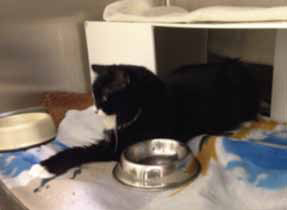
Scenario two — answer
Maintenance energy requirement (MER)
MER is the energy requirement of a moderately active adult animal in a thermoneutral environment. It includes the energy needed for obtaining, digesting and absorbing food in amounts to maintain body-weight, as well as energy for spontaneous exercise. The same equation used for calculating RER has traditionally been used to calculate MER in dogs and cats (Ramsey, 2012). The MER is then multiplied by a factor to take into account the age, activity level and physiological condition of the animal (Tables 3 and 4). These estimates of energy requirements should be used as guidelines rather than absolute requirements; patients should be assessed daily according to individual needs.
| Adulthood | Entire |
1.8 x RER |
| Reproduction | Pregnancy — first two thirds |
1.8 x RER |
| Growth | Less than 4 months of age |
3.0 x RER |
| Adulthood | Entire |
1.4–1.6 x RER |
| Reproduction | Early pregnancy |
1.6 x RER |
| Growth | Growing kittens | 2.5 x RER |
Unlike the RER, the MER is dependent on several factors including:
Every animal is an individual therefore prediction equations for calculating MER can only provide a rough estimate. Individual energy requirement must be altered according to personal requirements and response to feeding. Bodyweight should be monitored daily with both enteral and parenteral nutrition; however it is also essential to take into account fluid shifts when evaluating any changes. For this reason, a nutritional assessment is also important (Baldwin et al, 2010; Freeman et al, 2011). Regardless of the method of feeding, it is essential to accurately quantify and record an animal's dietary intake. If more than one type of diet is being offered, a careful measure of the amount of each must be made. Containers such as measuring cups are not always consistent therefore weight should be used over volume for an accurate quantification of food.
Scenario three
Tommo is a 9.8 kg, 12-year-old terrier crossbreed with a body condition score of 5/9 (Figure 3). On a routine visit to the veterinary practice to purchase some worming treatment and dog food, the owner has asked whether she is feeding the correct amount of diet to Tommo. The energy density of the diet is 275 kcal ME per sachet as fed.
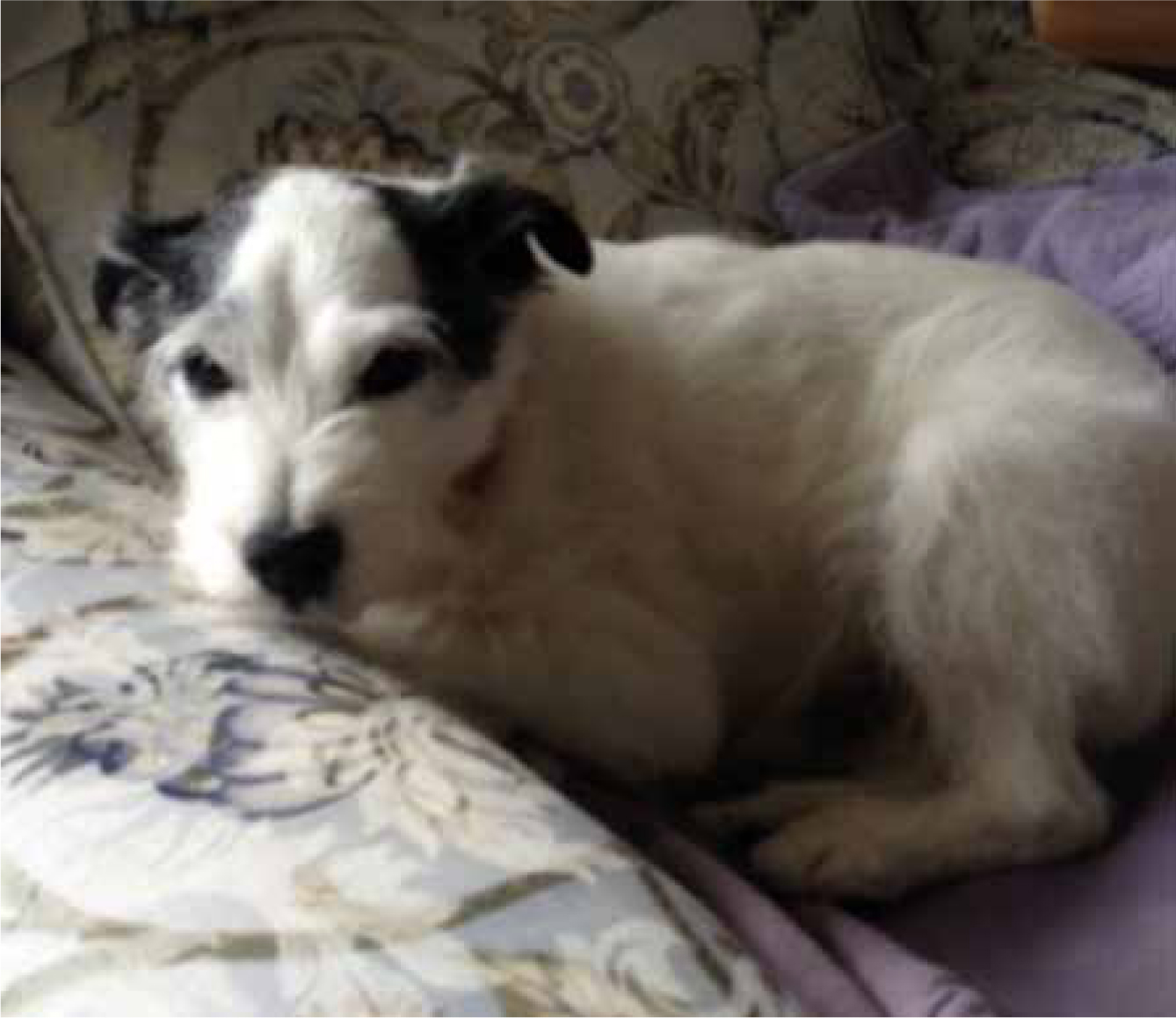
Scenario three — answer
It is important to ask the owner whether Tommo is receiving any other food such as treats, or food to hide medication in, as this will impact on the amount of diet to be fed. As part of every routine veterinary examination, Tommo should receive a nutritional assessment to ensure that this diet, its nutritional profile and the quantity being fed is appropriate for his species, age, lifestyle and health status.
Energy in relation to other nutrients
Provided it is palatable, animals will consume enough food to meet their energy requirements. To ensure the other essential nutrients are consumed in adequate quantities, these should be considered in relation to the energy content or energy density of the diet. Thus, when an animal finishes eating its diet, it should have consumed adequate quantities of the essential nutrients as well as energy (Gajanayake et al, 2011).
Comparing diets
When comparing diets, the nutrient content of different diets can be expressed according to the amount fed, the dry matter content or the kilocalorie content. This lack of uniformity can make comparisons between several diet options very challenging for pet owners. This can be further confused by some diets that make nutritional claims (e.g. low in fat). Even in the hands of a veterinary professional, comparing diets can be difficult and will necessitate a comparison based on the same unit.
Determining % of each nutrient (as fed) as a % of the dry matter (DM)
Depending on the formula of a diet, the moisture content can vary dramatically from ~5% in dry diets to up to 85% in some canned diets. When comparing different diets on a DM basis, the moisture content must first be subtracted. For example, a can of food containing 90% moisture will contain 10% DM.
% DM 1
Scenario four
An 8-year-old entire female Miniature Schnauzer, Macy, is examined out of hours following a 3-day history of depression and anorexia. The owners also report polyuria and polydipsia. On physical examination, Macy is depressed, febrile (temperature 39.5°C), tachycardic (125 bpm) and tachypnoeic (40 bpm). She weighs 7.1 kg and has a body condition score of 6/9. Findings on physical examination together with results of blood tests, ultrasound and in-house pancreatic lipase test provide a diagnosis of pancreatitis.
As Macy is at the upper end of the ideal bodyweight range and has suffered similar episodes of pancreatitis previously, part of the long-term management for chronic pancreatitis involves feeding a low fat diet. The owner has asked you to compare the fat content of Macy's current diet (A) with a prescription weight loss diet (B).
Determine the fat content of both diets on a dry matter basis.
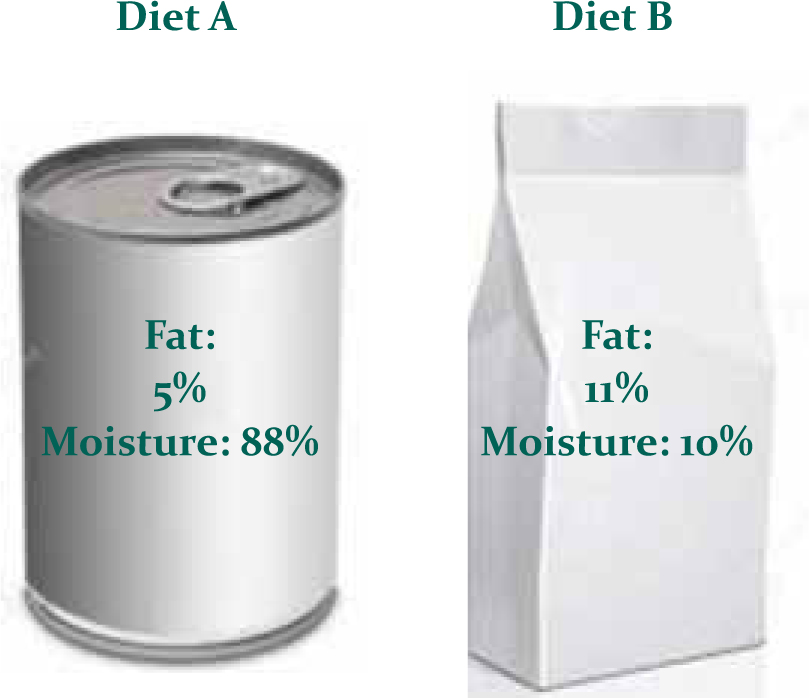
Scenario four — answer
Diet A
12% 1
Diet B
90% 1
The recommended level of fat (on a DM basis) for dogs with pancreatitis is 15% or less for non-obese dogs or 10% or less for obese/hypertriglyceridemic dogs therefore, in this scenario, diet B would be the preferred diet. However, it is also important to consider other key nutritional factors such as protein content; recommended levels on a DM basis for dogs with pancreatitis is 15–30% (Hand et al, 2010).
Determining nutrient content according to energy
This method provides a greater degree of accuracy since animals eat to satisfy their energy need and, assuming the diet is suitable, consumption of food should also mean that a sufficient amount of all other nutrients have also been consumed. With this method, nutrients are expressed in relation to the energy content of the diet, i.e. 20 g of protein per 100 kcal ME.
Scenario five
A 1-year-old Collie-cross, Dingo, is presented by the owner for veterinary examination suffering from patches of alopecia, scaly skin and loss of hair pigment. The veterinary surgeon suspects that these cutaneous manifestations could be linked with protein deficiency and has asked you to compare the two diets being fed.
Both contain 14% protein as fed but, due to the contrasting energy content, Dingo will eat a different amount of each diet to satisfy his energy requirement and thus, consume a varying amount of protein. How much protein is being ingested per 100 kcal ME?
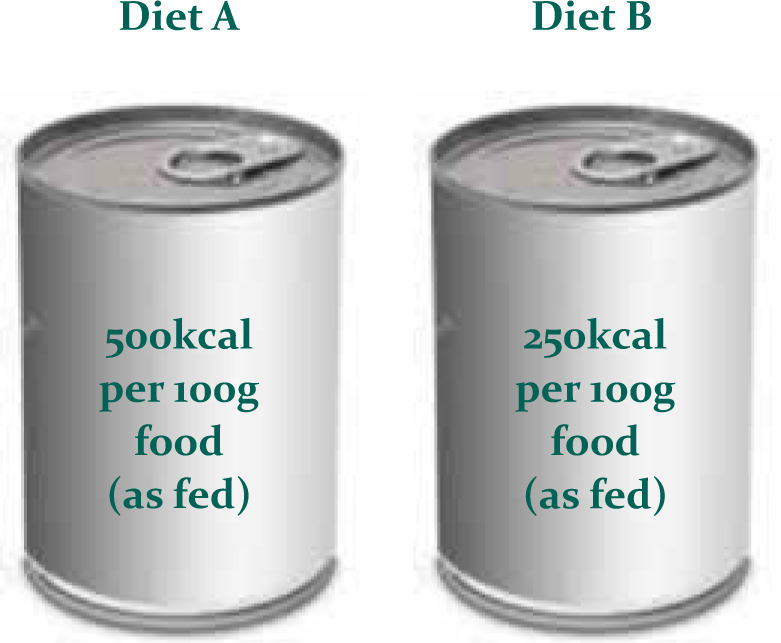
Scenario five — answer
Diet A
Diet B
According to the FEDIAF (2013), the minimum recommended protein levels for adult dogs is 4.5 g per 100 kcal ME suggesting that diet A may contain an insufficient amount of protein. However, it is important to consider that both diets contain the same amount of protein on a DM basis (14 g per 100 g) but, since animals eat to satisfy their energy needs, Dingo will consume twice as much of diet B to consume the same number of calories. In this situation, it would be important to review each diet, ascertain why two different diets are being fed, accurately quantify how much of each is being ingested and discuss any nutritional inadequacies with the owner. Clear nutritional recommendations and a justification for any dietary modification should be provided.
Calculating cost of food per day
When making a nutritional recommendation, it is important to appreciate the factors that can influence a pet owner's choice of food to feed their pet, of which cost is one.
To calculate cost per day:
Scenario six
Following on from a consultation with a veterinary surgeon, you have been asked to discuss the nutritional requirements of a cat with her owner. As a result of your discussion, the owner is considering changing the diet to one with a profile more accurately matched to his cat's age and lifestyle and he would like to compare the cost of the existing diet (A) and the recommended diet (B).
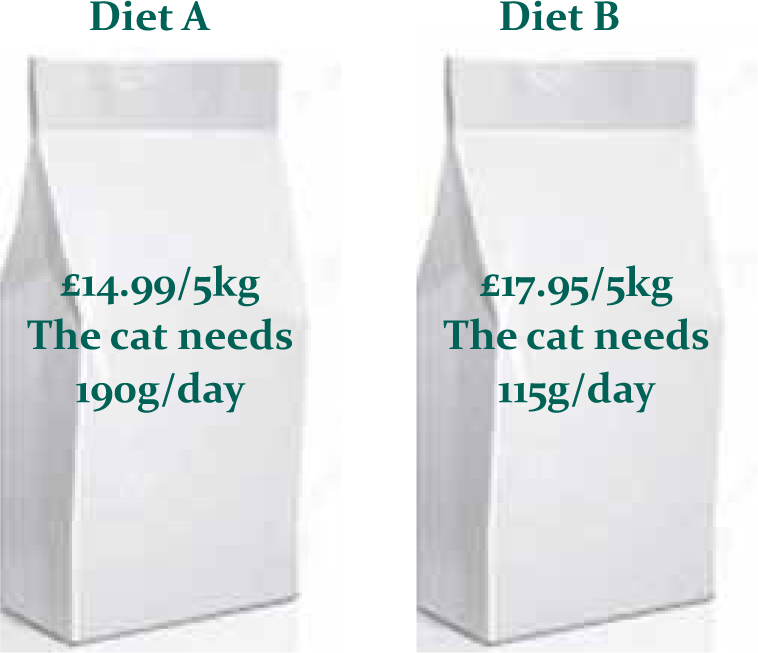
Scenario six — answer
Diet A (existing diet)
Diet B (recommended diet)
In this scenario, while diet A appears initially cheaper to buy, diet B would actually be more cost effective when calculated according to the quantity fed. Cost is often an important factor to pet owners when making decisions regarding choice of pet food. However, it remains key to promote a diet with a nutritional profile that aligns to the pet's species, age, lifestyle and health.
Conclusion
Within small animal practice, the nursing team is often responsible for providing nutritional support and so plays a fundamental role in nutritional intervention (Chan and Freeman, 2006). The implementation of nutritional support should be considered as part of a holistic approach to patient care and should be documented as part of a comprehensive nursing care plan.
Once nutritional intervention is considered necessary, the most appropriate method and route of delivery must be established alongside the patient's nutrient needs and feeding goals. These must all be considered in light of physiologic or disease condition. Based on a nutritional assessment, a plan is formulated to meet the energy and other nutritional requirements of the patient. The patient's underlying disease process, clinical signs and anticipated duration of nutritional support should be determined and factored into the plan. This will largely depend on clinical familiarity with the specific disease process and sound clinical judgment.
While more accurate predictive equations for pet food are available, the limitations associated with the application of these in a clinical setting often prohibit their use. Further details of such scientific calculations can be found within the list of references and further resources.

